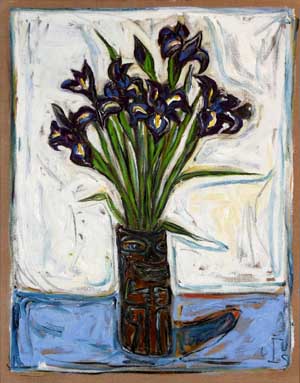
Exhibition: Billy Childish – Unknowable But Certain, The Institute of Contemporary Arts, London, until May 2 2010
In a poem on the wall, we find that Billy Childish once wrote: “I am a desperate man who loves the simplicity of/painting/and hates gallarys [sic] and white walls.”
Now that his recent paintings hang on the white walls of the ICA, one wonders where Childish stands. For more than 30 years he has, after all, played the role of outsider.
The hallmark of his poetry, music and art has always been the rejection of fashion, so perhaps it was inevitable that a cutting-edge public institution should one day pick up on the results.
In painting, Childish is famed for sticking with tradition. His work is expressionistic and raw. He offers the viewer flowers in vases, landscapes and outdoor portraits but, this being him, two of the latter feature a dead man.
An oil painting of a dark figure walking up a snowy hill
The oils are laid on thick and, when it comes to colour, Childish favours the putrid end of the spectrum. Yet the palette can shift before your eyes. In Man on Snowy Street, bright shades of lime and blue override a first impression of sickly greens and greys.
Most of these brushstrokes carry the weight of long years of suffering, which are well documented in the copious poetry also found in this show. Chatham’s least favourite son still bears the scars of a brutal upbringing.
Childish also has dyslexia and will leave the misspellings in his written work. It gives to his poems a mixture of pathos and humour they might otherwise not have. When he writes of late night “kabbabs” instead of “kebabs”, it somehow seems fitting.
Music is perhaps this artist’s best-known art form, and one room is given over to his many recordings with about half a dozen band, including Pop Rivets, Thee Mighty Caesars and Thee Headcoates.
The sound never strays too far from garage rock – his bands are as rough around the edges as his art and his poetry. Call it the punk approach, but it translates better onto vinyl than canvas or the printed page.
Written for Culture24.